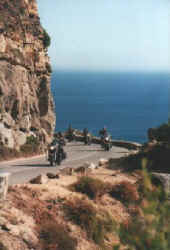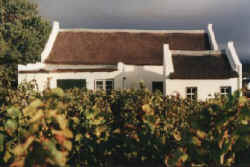INTO THE WEST: SOUTH AFRICA'S WESTERN CAPE BY HARLEY
by Laurianne Claase, Africa EditorThe horizon hurtles towards me at a hundred miles an hour with nothing between me and the rushing tarmac except the seat of my pants. At this speed, leg muscles clench with the effort of maintaining a steady centre of balance, the neck jars from resisting the whip of the wind and my brain is under threat of being vacuumed through my ears. "It'll rearrange your hormones," he'd said. And now I knew how.
The chrome and leather steed to which I cling is no ordinary motorcycle. It is a cultural icon and a Hollywood idol, a symbol of male potency, a fetish, a love-drug and a charm. It growls between the thighs and sets the blood to throbbing.
Designed and built by William Harley and the three Davidson brothers with the modest ambition of taking "the work out of bicycling," the original Harley was little more than a bicycle with a rudimentary engine and sling back handlebars. But those first three machines off the production line in 1903 spawned a world-wide, century-long phenomenon.
This success must in part be attributed to the spoils of war.
Their speed and handling saw the bikes used in skirmishes against Pancho Villa on the Mexico/Texas border and by 1914, they had proved their metal. 20 000 bikes saw action in the First World War and the factory's entire output of 90 000 motorcycles were used by the Allies in the Second.
The bike's manly prowess proved, Hollywood entrenched the legend. Easy Rider in 1969 saw Captain America cruise into the sunset, transporting Peter Fonda and Jack Nicholson into celluloid cool. The Harley's title as King of the Road was assured.
And here I was, about to get a good long look behind the testosterone curtain and find out just what it was about this purring hunk of metal that has made it the ultimate boy toy.
And as if that prospect were not inviting enough, four days lay before me of the vineyards and mountains, seascapes and sky of South Africa's Mediterranean
The Victorian writer Ruskin was of the opinion that "mountains are the beginning and end of all natural scenery." While the Western Cape has no shortage of either, its mountains also provide s-bends and roller-coaster curves, dizzying drops off perilous passes and the electric rush of two-wheeled adrenaline, for those so inclined.
I soon caught the bug.
I picked it up the next morning. Ensconced in back-rested comfort behind my 'chauffeur', resplendent astride a machine of burnished attitude, I was afflicted before we even set out but managed to resist the compelling urge to practice my royal wave.
Our road out of the city led thirty miles east to the foot of the once impenetrable Hottentots Holland. For the first white settlers to the Cape these mountains marked the end of the world. But now, where ox-wagons once had trundled, we followed on our Road Kings, towards Sir Lowry's Pass.
We hit the pass in a gusting southeaster that would have given Mike Tyson a run for his money. Feinting the left hooks and uppercuts, absorbing the glancing blows and ducking the knock-out punches I held grimly on, determined not to be a 'girl' and balk at the first sign of discomfort.
The summit successfully conquered, my laurels rested on a rainbow threaded over distant sea. And on under metal skies towards the break in the clouds past apple orchards and pine trees to the water and the wine.
The Western Cape is the wine-barrel of Africa. Grapes carpet vast tracts of its cultivated fields and our route lay through two of the most important areas; the Winelands just outside of Cape Town and the Breede River Valley, largest of the Western Cape’s fruit and wine producing valleys.
 The vineyards wear a look of summer sleekness, their elegant farmhouses reminiscent of an earlier, more permanent age. The low-slung, gabled facades, whitewashed and often thatched are ubiquitous throughout the Western Cape. The homesteads have been restored to a glory that was absent in their first incarnations as the modest, hand-hewn homes of the early settlers. As the vines prospered, so the original homestead was added onto and separate dwellings were built to house the eldest sons. The farmers’ cosmopolitan origins informed their architecture and medieval Holland, Huguenot France and later the islands of Indonesia contributed to a style of building that has become known as Cape Dutch.
The vineyards wear a look of summer sleekness, their elegant farmhouses reminiscent of an earlier, more permanent age. The low-slung, gabled facades, whitewashed and often thatched are ubiquitous throughout the Western Cape. The homesteads have been restored to a glory that was absent in their first incarnations as the modest, hand-hewn homes of the early settlers. As the vines prospered, so the original homestead was added onto and separate dwellings were built to house the eldest sons. The farmers’ cosmopolitan origins informed their architecture and medieval Holland, Huguenot France and later the islands of Indonesia contributed to a style of building that has become known as Cape Dutch.
But, we don't stop to sample the, uh, grape juice just yet. The road exerts its pull and we hit the trail. Or what used to be a trail. Once part of the wagon route that led to the north and the Kimberley diamond mines, Bains Kloof Pass is almost a hundred and fifty years old.
The Pass was completed by convict labour in 1853 at a rate of fifty three days a kilometre and without the aid of cement. It is no less impressive today than it must have been then. Gouged out of the rock-face high above the serpentine river, its bends and curves mimic the water's eddy. We sail the rocky currents and surf the rise and fall but the engine's steady hum fails to silence ghostly echoes of creaking wheels and cracking whips.
Down we swoop into Wellington and wine country once more. By now it is becoming difficult to ignore the clamour of the vines. In the Cape, fine wine is plentiful but this nearby vineyard is one of a kind.
Bought in 1988 by a senior advocate from Cape Town with a hankering for the land, the farm was bankrupt and derelict. With the coffers depleted by the purchase and no money to hire a farm manager, Alan Nelson decided on a plan of action which had at its core the idea of productivity. A contentious term this in South Africa and infinitely variable in both its concept and its practice but the soft-spoken gentleman farmer seems to have struck upon a working formula.
He turned to his farm labourers who for long years throughout the colonial history of this part of the world have been little better off than medieval serfs. The gist of the message was this. “You help me look after the farm and I’ll look after you.” Less than a decade later Nelson’s Creek’s ’96 Chardonnay was a South African Champion.
True to his word, Alan donated 9.5 hectares of land to his workers, almost a quarter of the farm in total and added another 2 hectares after a ’95 Cabernet also garnered an award.
Working now on their own vineyards as well as Nelson’s, the new landowners’ first liquid harvest appeared under the label of New Beginnings in 1998.
After an evening of Cape hospitality, morning comes as something of a shock. It carries us down Michell's Pass to Ceres and on into the Koue Bokkeveld , north towards the badlands of the Karoo. Through grape and grain country and undulating expanses of dry summer grass as the clouds paint shifting shadows on the hills. The horizon's rhythm is broken only by the hulking ruins of a windmill and occasionally a motley scattering of farms. The dirt roads that lead off to them bear signs for Lost Valley and Cold Comfort. The scrubby khaki ground cover tells the rest.
We veer south, away from the beckoning expanse of thirsty land and naked sky towards Agulhas where Africa falls away into the sea.
Here at the southernmost tip of the continent, Africa has been tamed. The eye glides over grazing lands and wheat stubble peppered with scrawny thickets of exotic shade. The waves trail whimsical ribbons of lapis lazuli and aquamarine in their wake. It is here that the Indian and Atlantic Oceans meet and it is from the distant southern waters that the whales come.
The winter waters of both seas are a summer holiday for calving whales and from July to November, the bays and coves and harbours of both the west and east coast erupt in giant tails and barnacled backs, frothings and leapings and thrashings and spoutings.
The best land-based whale watching in the world is reputedly to be had at Hermanus - a fishing village turned coastal Riviera. But being the end of summer, the old harbour is unruffled by visiting denizens from the deep and there is no sign of the resident whale crier with his kelp horn and sandwich boards.
As for us, we set sail on a salty breeze along the coast, past seas where whales birth in winter and great white sharks come to feed on fattened seals.
Back past the beaches and tidal pools, lighthouses and luxury villas of the Peninsula and up and over Chapman's Peak as the sky winds itself around my helmet and the road falls away beneath my boots.
Our triumphant return from the land over the mountain is suitably gratifying. Kids wave, teenage boys drool, lithesome girls in flouncy skirts cadge rides to the next traffic light and stressed-out suits in BMW's swivel their Ray-Bans to follow our passing.
93% of Harley Davidson owners are men. Now I know why. Whether one has the physique of Chubby Brown or the sex appeal of Mr Bean, a Harley transforms its rider into king of the road and master of the universe.
And when the pulsing brute is stilled and stabled and the road dust banished from the pores, the glamour lingers yet. For, beyond the fanfare and behind the legend, lies the endless fascination of the open road. And, with the wind still in my ears and the horizon's glitter in my gaze, I also know, "The best way to get there is just to go."
For information on more Southern African adventures contact:
easyAfrica Travel
TEL: +27 21 674 9967; FAX: +27 21 888 5003
MOBILE: +27 (0)82 898 7137
Images & Text © Laurianne Claase 1999-2007
